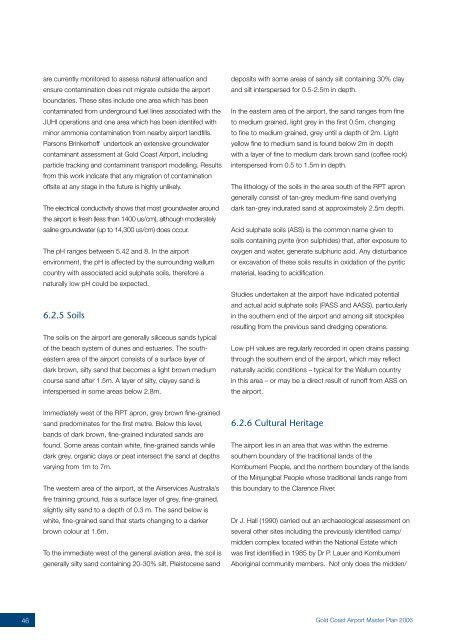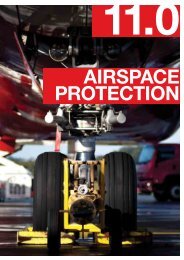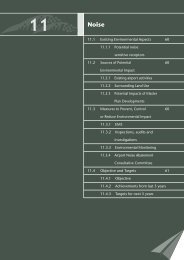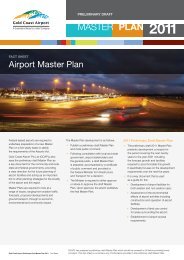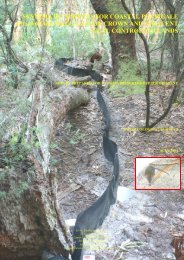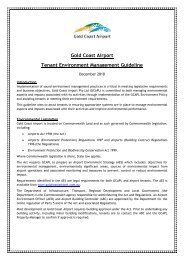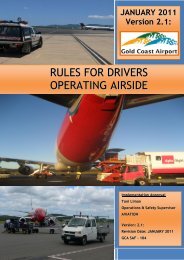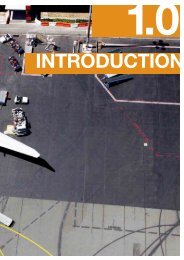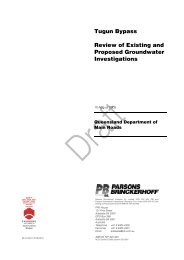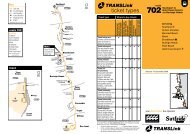Master Plan 2006 - Gold Coast Airport
Master Plan 2006 - Gold Coast Airport
Master Plan 2006 - Gold Coast Airport
Create successful ePaper yourself
Turn your PDF publications into a flip-book with our unique Google optimized e-Paper software.
are currently monitored to assess natural attenuation and<br />
ensure contamination does not migrate outside the airport<br />
boundaries. These sites include one area which has been<br />
contaminated from underground fuel lines associated with the<br />
JUHI operations and one area which has been identifed with<br />
minor ammonia contamination from nearby airport landfills.<br />
Parsons Brinkerhoff undertook an extensive groundwater<br />
contaminant assessment at <strong>Gold</strong> <strong>Coast</strong> <strong>Airport</strong>, including<br />
particle tracking and contaminant transport modelling. Results<br />
from this work indicate that any migration of contamination<br />
offsite at any stage in the future is highly unlikely.<br />
The electrical conductivity shows that most groundwater around<br />
the airport is fresh (less than 1400 us/cm), although moderately<br />
saline groundwater (up to 14,300 us/cm) does occur.<br />
The pH ranges between 5.42 and 8. In the airport<br />
environment, the pH is affected by the surrounding wallum<br />
country with associated acid sulphate soils, therefore a<br />
naturally low pH could be expected.<br />
6.2.5 Soils<br />
The soils on the airport are generally siliceous sands typical<br />
of the beach system of dunes and estuaries. The southeastern<br />
area of the airport consists of a surface layer of<br />
dark brown, silty sand that becomes a light brown medium<br />
course sand after 1.5m. A layer of silty, clayey sand is<br />
interspersed in some areas below 2.8m.<br />
deposits with some areas of sandy silt containing 30% clay<br />
and silt interspersed for 0.5-2.5m in depth.<br />
In the eastern area of the airport, the sand ranges from fine<br />
to medium grained, light grey in the first 0.5m, changing<br />
to fine to medium grained, grey until a depth of 2m. Light<br />
yellow fine to medium sand is found below 2m in depth<br />
with a layer of fine to medium dark brown sand (coffee rock)<br />
interspersed from 0.5 to 1.5m in depth.<br />
The lithology of the soils in the area south of the RPT apron<br />
generally consist of tan-grey medium-fine sand overlying<br />
dark tan-grey indurated sand at approximately 2.5m depth.<br />
Acid sulphate soils (ASS) is the common name given to<br />
soils containing pyrite (iron sulphides) that, after exposure to<br />
oxygen and water, generate sulphuric acid. Any disturbance<br />
or excavation of these soils results in oxidation of the pyritic<br />
material, leading to acidification.<br />
Studies undertaken at the airport have indicated potential<br />
and actual acid sulphate soils (PASS and AASS), particularly<br />
in the southern end of the airport and among silt stockpiles<br />
resulting from the previous sand dredging operations.<br />
Low pH values are regularly recorded in open drains passing<br />
through the southern end of the airport, which may reflect<br />
naturally acidic conditions – typical for the Wallum country<br />
in this area – or may be a direct result of runoff from ASS on<br />
the airport.<br />
Immediately west of the RPT apron, grey brown fine-grained<br />
sand predominates for the first metre. Below this level,<br />
bands of dark brown, fine-grained indurated sands are<br />
found. Some areas contain white, fine-grained sands while<br />
dark grey, organic clays or peat intersect the sand at depths<br />
varying from 1m to 7m.<br />
The western area of the airport, at the Airservices Australia’s<br />
fire training ground, has a surface layer of grey, fine-grained,<br />
slightly silty sand to a depth of 0.3 m. The sand below is<br />
white, fine-grained sand that starts changing to a darker<br />
brown colour at 1.6m.<br />
To the immediate west of the general aviation area, the soil is<br />
generally silty sand containing 20-30% silt, Pleistocene sand<br />
6.2.6 Cultural Heritage<br />
The airport lies in an area that was within the extreme<br />
southern boundary of the traditional lands of the<br />
Kombumerri People, and the northern boundary of the lands<br />
of the Minjungbal People whose traditional lands range from<br />
this boundary to the Clarence River.<br />
Dr J. Hall (1990) carried out an archaeological assessment on<br />
several other sites including the previously identified camp/<br />
midden complex located within the National Estate which<br />
was first identified in 1985 by Dr P. Lauer and Kombumerri<br />
Aboriginal community members. Not only does the midden/<br />
46 <strong>Gold</strong> <strong>Coast</strong> <strong>Airport</strong> <strong>Master</strong> <strong>Plan</strong> <strong>2006</strong>


